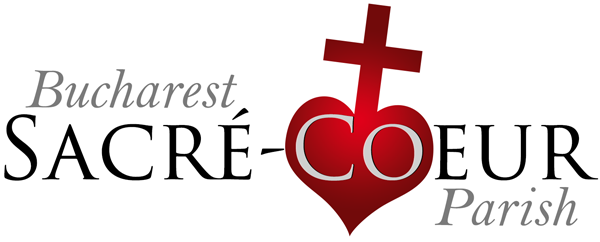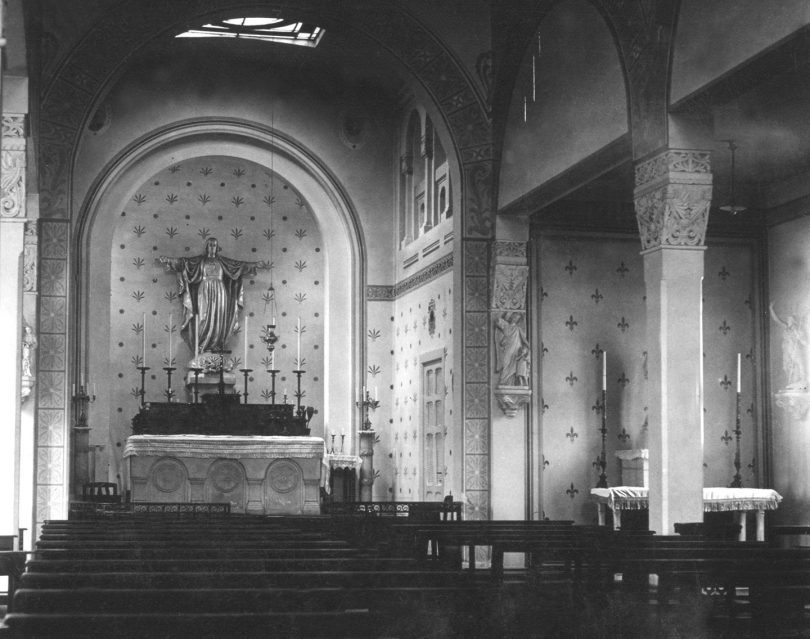1906 – 1930: The Daughters of Charity of Saint Vincent de Paul
The origins of our parish date back to the arrival in Romania, in 1906, of the Daughters of Charity of Saint Vincent de Paul, called by Prince Vladimir Ghika. He had known, admired, and shared their dedication among the poor in Thessaloniki, where his brother Demetre was Consul.
The first three Sisters founded in the Grivitza district, not far from the North Station, a small dispensary “Bethleem Mariae”. During the 2nd Balkan War between the Black Sea neighbors (1913), the Sisters of Charity worked with Prince Ghika in an ambulance service treating victims of cholera, notably in Bulgaria. Their mentor was awarded a civil military medal. During the First World War, fleeing Bucharest occupied by the Germans, they accompanied the army, the government, King Ferdinand, and Queen Marie to Moldavia. Sister Pucci died there of dysentery.
Around 1912 the Sisters of Charity acquired an old hunting lodge on Jianu Road on the grounds of which the St. Vincent de Paul Hospital – today Dr Parhon Hospital Aviatorilor Bd no. 34 – was soon erected, complete with a maternity ward and a dispensary where volunteer doctors provided free care, the wealthy paying for the poor. Sister Soize presided over the realization of this beautiful project, supported by Prince Vladimir Ghika (born Orthodox, he joined the Catholic Church in 1902). In 1930, a large public chapel (which became our parish church) was erected, served by the Lazarist Fathers, for whom a presbytery was built at another corner of the quadrilateral. They also served as chaplains to the hospital complex and the community of Sisters.
In the meantime, in 1923, at the age of 50, Prince Ghika became a priest in Paris. Chaplain of foreigners, priest in the red suburb of Villejuif where he laid the foundations of a future parish, founder of a new community in Auberive on the Langres plateau, chaplain of the International Eucharistic Congresses, he returned every summer for a few weeks to his family in Bozieni in Moldavia.
1939 – 1957: Monsignor Ghika and the closure of the “French Chapel”
When the Second World War broke out, the hospital of the Sisters of Charity took in sick and wounded Polish refugees. Mgr Ghika (he was not a bishop, but an honorary prelate), having chosen and obtained not to return to France, settled in with his brother and actively participated in the apostolate around the Greek-Catholic parish of Saint Basil on the one hand, and the Latin church of Saint Vincent de Paul and the hospital services on the other.
In 1944, with the advance of the Red Army, a change of alliance: King Michael overthrows Marshal Antonescu, the Americans bomb Bucharest, the Germans retreat, and the Soviet Army arrives as a liberator, preparing the local communist power (Anna Pauker; Petru Groza, Gheorghe Gheorhiu-Dej, and others) – first with the forced abdication and exile of King Michael (December 1947), then the installation of a short-lived puppet republic presided over by the honorable Dr Parhon, a renowned endocrinologist. The hospital where he worked, like all Church institutions, is confiscated: to save what can be, the Daughters of Charity sell it to the French State, represented by Robert Schuman, then Minister of Foreign Affairs.
In Autumn 1948, the Sisters were banned from activities, expelled from their convent. The older ones grouped together in a house in the neighbourhood, with a postulant who remained until 1990. The younger ones were dispersed or sent to Oradea. But the communists refrained from occupying the church and the presbytery, where Fathers Schorung and François Van der Jonckheydt, a Belgian, resided. It was there that Monsignor Ghika found refuge until his arrest on 18 November 1952. Father Schorung having been recalled to France, Father Van der Jonckheydt remained the sole servant of the church until his expulsion in 1957 and the closure of the “French Chapel”.
For more than 30 years, the church remained closed, suffering severe damage during the 1977 earthquake. The French state undertook essential repairs (installation of the metal rods that still maintain its structure today). The presbytery served as temporary housing for school cooperators. From the 1980s, twice a year at the major festivals, a French priest came to celebrate mass for the members of the diplomatic corps.
After 1989: The reopening of the parish after the revolution
As early as January 1990, with the support of a group of French-speaking Africans, Archbishop Ioan Robu took steps to obtain the reopening of the Sacred Heart Catholic Church. These efforts succeeded in 1991, and from April, the church was opened every Sunday for a mass in French. Father Ioan Ciobanu was appointed priest of a new Romanian territorial parish, while a French-speaking priest ensured pastoral care for this linguistic community.
The Society of Jesus, seeking to redeploy in the country, proposed one of their own for this post. Father Luc Duquenne arrived in Bucharest on 17 November 1991. On Monday 18, the church was restored to daily worship. The parish was canonically established on 1 December 1991.
Upon his arrival, families asked for the catechism service to be established for children of the French school (Anna-de-Noailles College and Lyceum), and they offered their collaboration. A significant group of African prayer forms the basis of the choir. During the summer of 1992, the presbytery was returned to our disposal. In 1995, questions of property between the Romanian and French states were resolved: the hospital remained Romanian. A convention now governs relations between the Latin archdiocese of Bucharest and the French state, owner of the church and the parish house. A chaplaincy is fully established in the French school’s framework.
The Romanian community is large, practising, and the church is small. On Sundays, three masses are not too many to provide this service, in which Father Luc Duquenne assists the Romanian priest (Eucharist, confessions …). From 1998, the abundance of Romanian vocations allows the addition of a vicar to their community service. Fathers Francisc Cosa, Ciprian Bejan, Marcel Lungeanu, Liviu Bulai, Maximilian Lucaci, and Ioan-Thomas Raileanu will successively serve there. In 1999-2000, the tiny presbytery was enlarged with a new wing, an additional floor and several rooms, as well as an enclosing wall with a gallery, as we know them today. In May 2005 a statue of Monsignor Ghika, a replica of that in the National Museum, was erected on the square which soon took his name.
From Advent 1992, at the insistence of families of Nigerian diplomats, Father Georg Sporschill, an Austrian Jesuit, founder of the Concordia network for street children, inaugurated the Saturday evening mass in English. At Christmas 1995, a member of this community, an Iraqi international official, requested a celebration for his Chaldean rite compatriots: there were more than a hundred, merchants, refugees… Their community organised, and we took turns celebrating a modified “Latin” liturgy for them.
From 2008, the Maronite Lebanese obtained a resident priest and founded a new parish. Father Zakhia Zgheib, their priest, also took charge of the Chaldean community of Arabic language, which continues to meet at the Sacred Heart, on Saturday evenings or Sunday afternoons depending on the seasons. For some years now, the Lebanese community has built its parish in Dimieni, near Bucharest, where it meets each week.
In the summer of 2010, Father Eduard Giurgi succeeded Father Ioan Ciobanu as priest of the Romanian parish. He is also a doctor of canon law, an ecclesiastical judge for the diocese of Bucharest and a professor at the theology university of Bucharest.
In the autumn of 2011, Father Michel Kubler, a French Assumptionist, became chaplain of the French-speaking community until September 2015.
On 16 September 2015, Father Ioan-Thomas Raileanu, a priest of the diocese of Bucharest and also vicar of the Romanian parish of the Sacred Heart, was appointed the new Chaplain of the Francophone community of the Archdiocese of Bucharest.
From 1 September 2021, Father Francisc Dobos was appointed the new rector of the parish. He is in charge of the Romanian community, the English-speaking community, and the Filipino community. He also celebrates the mass in English every Saturday at 6 pm and on the third Sunday of the month at 2 pm, he celebrates mass for the Filipino community of Bucharest.
The Francophone community is a multinational community (13 nationalities are counted in the parish), with many young families and children. Every Sunday 150 people gather for Sunday mass at the Sacred Heart Church. Catechesis is offered to about 100 French-speaking children and young people every week. Numerous pastoral activities are proposed throughout the year for adults and families.
Deo Gratias!

